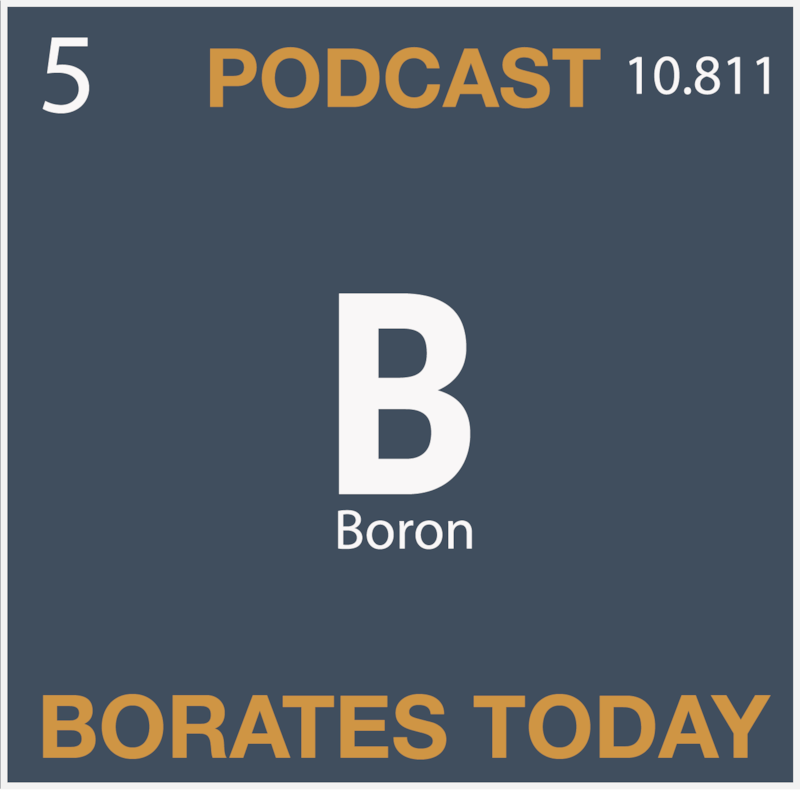
Shownotes
In today's podcast, we're going to look at research into how boron can be used as rocket fuel. Boron has a high intrinsic energy density. It's inexpensive, plentiful, and stable, making it a good choice for solid rocket fuels and an additive for jet fuels to increase energy output.
However, the oxide shell and its impurities make boron unreliable at the ignition point. Research is ongoing into overcoming these impurities so that boron fuel may be used more widely in space travel.
Transcripts
Welcome back to the Borates Today podcast.
Brendan:Each week we cover a topic that is relevant to the industry and timely.
Brendan:We cover the latest industry news.
Brendan:Who are the key players in the sector?
Brendan:What are the latest trends, driving demand and supply for boron.
Brendan:What is the science behind boron and who's doing valuable research into
Brendan:new boron applications and benefits?
Brendan:We look at how boron helps in advanced energy, in food security,
Brendan:and in providing nutrition.
Brendan:So don't forget to check out boron applications and benefits
Brendan:on our website borates.today.
Brendan:In . Today's podcast, we're going to look at research into how
Brendan:boron can be used as rocket fuel.
Brendan:Boron has a high intrinsic energy density.
Brendan:It's inexpensive, plentiful and stable, making it a good choice for
Brendan:solid rocket fuels and an additive for jet fuels to increase energy output.
Brendan:However, the oxide shell and its impurities make boron
Brendan:unreliable at the ignition point.
Brendan:Research is ongoing into overcoming these impurities so that boron fuel may
Brendan:be used more widely in space travel.
Brendan:Boron Focket Fuel
Brendan:Herman Krier, Richard W.
Brendan:Kritzer, Professor of Mechanical and Industrial Engineering at the
Brendan:University of Illinois have stated that rocket performance is determined
Brendan:by energy per pound of propellant.
Brendan:If the rocket can carry less propellant, it has more payload.
Brendan:Liquid fuels or oxidizers offer more energy per pound than solid propellants.
Brendan:However, liquids must be cryogenically cooled, which adds to the cost
Brendan:and makes them difficult to store.
Brendan:Solid propellants can be safely stored for many years, even in harsh environments
Brendan:and are also cheaper to produce.
Brendan:Solid fueled rockets today use propellants dating back from the 1960s and seventies.
Brendan:Krier stated that these materials are safe and reliable but not very energetic.
Brendan:New propellants are likely to contain high energetic metals like magnesium and boron.
Brendan:Krier said that boron is a desirable additive for rocket
Brendan:fuels because of its low molecular mass and high combustion energy.
Brendan:Specifically speaking, the bi-propellant composed of boron and
Brendan:nitrogen produces large quantities of hot gases in a short time.
Brendan:These gases are helpful for many purposes including providing the
Brendan:thrust necessary for rockets.
Brendan:Additionally boron carbide has a high combustion enthalpy.
Brendan:Boron carbide can be easily manufactured using well-known
Brendan:electric furnace techniques and is also readily available at low cost.
Brendan:These boron carbide solid oxidizing agent mixtures can be stored for as
Brendan:long as one wants without deterioration or danger of premature ignition.
Brendan:These mixtures are so stable that an igniter is needed to start the
Brendan:reaction between the components.
Brendan:Boron carbide has been considered a good fuel component for solid
Brendan:rocket propellant compositions.
Brendan:Rocket propulsion can also be achieved using a bi-propellant made
Brendan:of boron and nitrogen compounds.
Brendan:A nitrogen containing combination that is only composed of carbon, hydrogen,
Brendan:and nitrogen, is also combined with a boron containing compound composed
Brendan:of carbon, hydrogen, and carbon.
Brendan:At least one reactant needs to contain hydrogen and at least one
Brendan:reactant needs to contain carbon.
Brendan:In a 2015 study published in aerospace research central, a composition consisting
Brendan:of 80% polytetrafluoroethylene and 20% boron by weight was considered a potential
Brendan:high density, solid fuel mixture for mixed hybrid rocket propulsive applications.
Brendan:What are the Challenges and Ongoing Research Related to Boron Combustion?
Brendan:There has been extensive research on board and as solid rocket fuel
Brendan:and as an additive to jet fuels.
Brendan:However, this propellant has been difficult to tame due to its variable
Brendan:and complex combustion behavior.
Brendan:Alla Pivnika, Nikita Muravyev, and colleagues from the Semonov Federal
Brendan:Research Center for Chemical Physics in Moscow have conducted a series of
Brendan:experiments to explain why this is.
Brendan:Pivnika says that boron particles cannot be ignited easily because the solid
Brendan:boron core has an oxide shell which acts as a protective coating, delaying
Brendan:or preventing ignition and combustion.
Brendan:So, how to figure out the thermal behavior?
Brendan:The researchers discovered that different boron powders have
Brendan:different shell compositions because of various impurities,
Brendan:such as magnesium and aluminium and their oxides during production.
Brendan:Pivkina says we demonstrated that boron particles with differing
Brendan:impurities within the oxide shell have significantly changed thermal behavior.
Brendan:The researchers reported their findings in the journal Combustion,
Brendan:Explosion and Shockwaves.
Brendan:They have now shown that impurities can either hinder or
Brendan:enhance combustion performance by thermal analysis of the powder.
Brendan:Pivkina also reported that they found that aluminimum and magnesium oxide
Brendan:impurities reduced evaporation of the boron oxide and thus decreased
Brendan:the activity of boron ignition.
Brendan:In contrast, magnesium fluoride had the opposite effect.
Brendan:The oxide layer goes through melting, dehydration, and
Brendan:evaporation during heating.
Brendan:Each step takes place at a different temperature, depending
Brendan:upon the presence of impurities.
Brendan:Researchers discovered that magnesium and aluminium undergo metallic thermite
Brendan:reactions with boron oxide, which can cause problems with combustion
Brendan:and leave unwanted oxide residues.
Brendan:However, magnesium fluoride forms boron fluoride gas at a
Brendan:thousand degrees centigrade.
Brendan:This promotes the evaporation and activation of the boron core at around
Brendan:1300 degrees centigrade, which helps reduce troublesome ignition delay.
Brendan:The conclusion for Pivkina and his team is to carry out ongoing investigation
Brendan:into a variety of binders to optimize combustion of boron-based fuels.
Brendan:The results will open up new avenues for the ignition and combustion of boron
Brendan:particles in energetic formulations.
Brendan:For more information on boron and rocket fuels please refer
Brendan:to the Borates Today website.
Brendan:And that's all for today.




